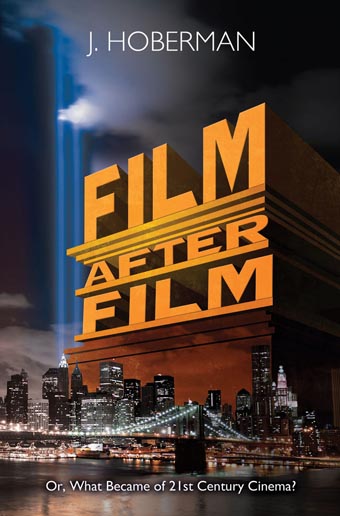“Spirited, thought-provoking and popping with fresh perspectives, J. Hoberman‘s new book, Film After Film: Or, What Became of 21st Century Cinema? (Verso), reframes the future of cinema in the nervous light of the past decade—that is, the first 10 years (or so) of the 21st century, a period marked by the proliferation of digital technology, the ubiquity of viral culture and the aftershocks of 9/11.” So begins Steve Dollar‘s introduction to his interview with Hoberman for the Wall Street Journal. Up for discussion is not only the new book (and this’ll be the entry in which we collect pointers to reviews as they come in) but also the Film After Film exhibition opening tomorrow at the Museum of the Moving Image (on view through October 28), accompanied by a film series Hoberman’s curated, running from September 15 through 30.
Among the highlights of the exhibition: Pat O’Neill’s The Decay of Fiction (2002), screening on a continuous loop, Joe Swanberg’s LOL (2006), presented on an iPad (Hoberman to Dollar: “As someone who teaches film at a university, I know that’s how students watch their movies now. It’s a fact of life”), and Chris Marker‘s CD-ROM Immemory. As it happens, the New York Review of Books has just posted Hoberman‘s appreciation of Marker:
Hardly a Luddite, Marker thrived on technological paradox. A half-hour succession of still images evoking motion pictures as time travel, La Jetée could have been made for Eadweard Muybridge’s nineteenth-century zoopraxiscope.
For much of his life, Marker functioned as a foreign correspondent, a romantic leftist in the Malraux mode travelling the world from West Africa to Siberia. Most of his early films were personal travelogues—short features notable for their wry, poetic voiceover narration and serendipitous approach to foreign societies. “Modern adventure, Marker understands, is not updating lost paradises, but discovering new places,” observed Cahiers du Cinéma critic Andre S. Labarthe in 1961. “No longer the Indies, but Communist China, no longer the Amazon, but Cuba, no longer Palestine, but Israel.” Today one might call these places failed utopias—or, perhaps, in a more Markerian formulation, places haunted by their lost futures.
Back to the Museum for a moment. In conjunction with the film series, “Phil Solomon’s immersive three-screen HD installation American Falls (2010, 55 mins.)… [will transform] the Museum’s 4,000-sq. ft. third floor gallery into a panoramic and artistic journey through the catacylsms of American history, and an elegy to the film medium that welcomes a new era of mixed medias.”
And back to the book: The L Magazine is running an excerpt it’s calling “How 9/11 Changed Hollywood.” The gist? “Hollywood expected to be punished. Instead, it was drafted.”
Update, 8/31: IndieWIRE‘s running excerpts from the book. The overall argument is not “that twentieth-century cinema no longer exists—even nineteenth-century cinema is with us still. But the digital turn, accompanied by a free-floating anxiety regarding the change in cinema’s essential nature and a cataclysmic jolt out of the clear blue sky that, for the vast majority of the world’s population, was apprehended as a manmade cinematic event, have all combined—perhaps conspired—to create something new. That new thing is the subject of this book.”
Update, 9/6: At Cinespect, Nathan Rogers-Hancock writes that “much of Hoberman’s work to this point, including the critical histories The Dream Life: Movies, Media, and the Mythology of the Sixties and Army of Phantoms: American Movies and the Making of the Cold War operates on the assumption of film’s central place in the American consciousness (the conceit of ‘the dream life’) and the central place of the United States as a nation in the world. As we continue to shift into the twenty-first century, we see both of those paradigms shifting; we are no longer in the American century, and more and more the ‘dream-life’ of our country is disconnected from film, and perhaps Hollywood film in particular.”
For news and tips throughout the day every day, follow @KeyframeDaily on Twitter and/or the RSS feed. Get Keyframe Daily in your inbox by signing in at fandor.com/daily.




